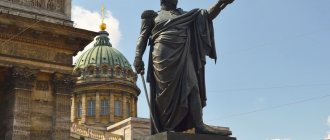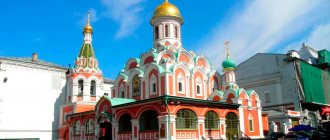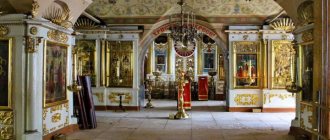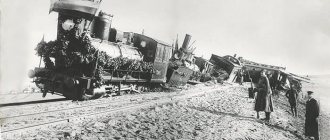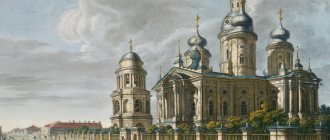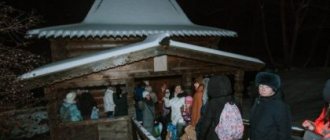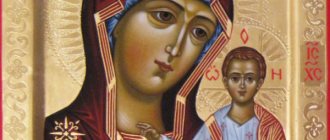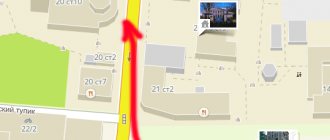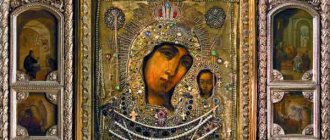The Kazan Cathedral on the corner of Red Square in Moscow has a difficult fate. It was completely demolished in 1936 and rebuilt 57 years later. Today it is a functioning temple where services are held. The main shrine of the cathedral, which believers from all over the country come to worship, is the Kazan Icon of the Mother of God, revered as miraculous, with its relic guardian. The rector of the temple is Archpriest Nikolai Inozemtsev.
Tourists most often visit the cathedral when visiting the main attractions of the capital - Red Square, Alexander Garden, St. Basil's Cathedral, State Historical Museum and other popular sites near the Moscow Kremlin.
© Igor Butyrskii
Hotels near the Kazan Cathedral in Moscow
Schedule of services of the Kazan Cathedral on Red Square
Those wishing to receive the Sacrament of Baptism can contact the ministers for a public conversation every Saturday at 15:00.
Religious events take place daily in the temple:
- 08:00 (weekdays) 08:30 (Sat) and 09:00 (Sun) - liturgy,
- 14:00 (Sat) - Unction
- 17:00 - evening services (parastas, all-night vigil).
On the website of the Kazan Cathedral you can see a detailed schedule of events for the current month, as well as find out the names of the clergy who will conduct the rituals and their assistants.
© Official website of the Moscow Patriarchate
Schedule of services 2022 on the official website of the Cathedral of the Kazan Icon of the Mother of God
History of the Kazan Icon of the Mother of God
The Holy Icon of the Kazan Mother of God is revered by Orthodox believers. Moreover, both the icon itself and its copies are considered miraculous. They are distributed throughout all parishes of the world and are especially revered by Christians.
The icon appeared after an extraordinary event that occurred in the 16th century.
The fire of 1579 in Kazan completely destroyed all wooden houses and buildings. The girl Matrona saw a strange dream in which the Mother of God appeared to her. She persistently asked Matrona to go to the fire and look for an icon among the burnt logs.
The girl told her mother and father about the request of the Mother of God. The parents asked priest Ermolai for a blessing and went with their daughter to the ashes. And indeed, under the black skeletons of the boards lay an icon. She was wrapped in cherry-colored cloth and untouched by the flames. On a wooden board we saw an image of the Virgin Mary.
The healing power and strength of the icon was immediately discovered. The blind began to see, the deaf began to hear, the terminally ill recovered. The spiritual rulers of Kazan instructed craftsmen to make copies of the miraculous icon. One was sent as a gift to Tsar Ivan the Terrible. The rest were sent to churches throughout all territories of Rus'. The icons were kept in the main parishes and were worshiped by thousands of believers.
In honor of the found icon, churches, chapels, and parishes were built. On the site of the ashes, in Kazan, an Orthodox monastery was erected. Matrona became a nun and began to serve God, calling herself Mavra. In modern times in the Orthodox world, the feast of the holy icon is celebrated on July 8.
Icon of the Moscow Kazan Cathedral
The Kazan Icon of the Mother of God is one of the most revered shrines not only in the Kazan Cathedral, but in Christianity in general. It is worth noting that the temple does not store the original icon, but a copy of it, but this does not detract from its significance. There is a copy in the Dmitrovsky chapel.
© Official website of the Moscow Patriarchate
The first appearance of the icon of the Mother of God happened in 1579 in Kazan. Its location was shown by the girl Matrona, who had a prophetic dream. After its discovery, the icon was repeatedly moved to other churches in the country; many copies were made from it, practically indistinguishable from the original.
To avoid damage and theft, copies were often displayed in churches, and the original was carefully guarded. However, in 1904, the icon was stolen; the thief turned out to be the peasant Chaikin, who said that he burned the relic. Later, versions were put forward according to which the destruction of the Kazan Icon of the Mother of God was called into question. Until now, historians cannot come to a definite opinion whether the original of the Kazan Icon of the Mother of God has survived and where it may be located.
Local shrines
The most revered temple shrine is the miraculous icon of the Mother of God “Sovereign”. In addition, within its walls there is a revered copy of the Kazan Icon of the Mother of God. And in the northern part of the building you can see a unique wooden sculpture that depicts Jesus Christ and was previously located in the central part of the church.
We recommend paying attention to suitable icons: Kazan Icon of the Mother of God from mosaic (Size 30*40 cm)
45 000 ₽
More details Handwritten Kazan icon with carvings 13
Price from: 23,500 RUR
More details Handwritten Kazan icon with pearl frame 4 (Size 21*25 cm)
58 000 ₽
More details
History of the temple
The first cathedral building, built in the 1620s, was made of wood. The construction of a new temple dedicated to the war of 1612, in which Russia won, was sponsored by Dmitry Pozharsky. The building was damaged in a fire and was rebuilt in the 1630s. Until 1765, on days of celebration of particularly significant events (military victories, discovery of an icon), religious processions were held before the Kazan Cathedral.
In subsequent years, the temple was rebuilt and repaired several times. The last restoration took place in 1925. Architect Pyotr Baranovsky wanted to return the building to its original appearance. The work lasted for 4 years, and when very little remained, the Moscow City Council decided to demolish the temple. The restoration stopped, the bell tower was destroyed in the same year, and the cathedral premises were used until 1936 as a warehouse for storing building materials for the metro station. After the demolition of the Kazan Cathedral, a pavilion in honor of the Third International was placed in its place.
In 1990, the Moscow authorities decided to rebuild the cathedral, and therefore began collecting donations. The shrine was restored using photographs and drawings preserved in the archives. Work on recreating the Cathedral of the Kazan Icon of the Mother of God ended in 1993.
Panorama of the temple from Red Square:
Interesting facts about the Kazan Temple
There are many interesting facts and events in the history of the Cathedral of the Kazan Icon. For example:
- it was in this place that Catherine II was proclaimed autocratic empress;
- Three colors were initially used in the design: gold, as the color of Christianity, red, as the color of fire and blood, white, as the color of innocence and purity - in the Byzantine tradition, this combination denotes military valor;
- The Kazan Icon did not remain in the Cathedral all the time - it was taken to St. Petersburg under Peter I.
Russian tsars often took part in religious processions at the Kazan Church.
Figure 4. Procession from the cathedral
Architecture
The Cathedral of the Kazan Icon of the Mother of God is a typical example of temple architecture of the first half of the 17th century. This is a single-domed temple with two chapels. The northern and southern aisles are united by a gallery that surrounds the structure on three sides.
The exterior of the cathedral is decorated with mosaic icons in the Russian style. They depict the Mother of God, Jesus Christ, St. George the Victorious, the Patriarch of Moscow and other saints.
© Official website of the Moscow Patriarchate
Architecture Features
Initially, the temple building was adjacent to the house and was connected to the royal palace by a small passage, the length of which was 50 meters and the width of 3 meters. According to ambassadors from Poland who visited the covered passage of the Kolomna Church of the Kazan Icon of the Mother of God in 1671, it was made of stone, had large windows and handmade carpets that made walking easier. In the northern part of the building there is a porch, which serves not only as the bell base, but also as a means of transition to the bell tower itself.
How to get there
The Kazan Cathedral is located in the center of Moscow on Nikolskaya Street. Getting to it is not difficult - several metro stations and public transport stops are within walking distance from the shrine. You can also take a taxi or go by car.
Metro
The metro is perhaps the most convenient transport in the capital. From the station closest to the cathedral, “Okhotny Ryad” (red line), walk only about 100 meters from exit No. 7. In addition, the Teatralnaya station (green line) is nearby, and a little further “Revolution Square” (blue line).
Moscow metro map - Yandex. Metro
View of the cathedral from Nikolskaya street:
Public transport
300 meters away, near the Okhotny Ryad metro station, there are stops: Okhotny Ryad Metro and Manezhnaya Ploshchad. Buses and minibuses run here: No. M2 (to Rizhsky Station), M3, M10, M27, H1 (night to Sheremetyevo Airport), H2 (night), H11 (night to Vnukovo Airport), H12, 101, 144 , 904.
A little further (on the opposite side of Red Square, near St. Basil's Cathedral) there is another bus stop - “Red Square”. Buses No. M5 and 158 depart from it.
Moscow public transport portal
Current state[edit]
The artistic significance of the Kazan Church, which was previously directly part of the sovereign's palace, with which it was connected by covered passages, is small. For this reason, she shows us the most typical, well-developed church building of the second half of the 17th century, examples of which we find quite a large number both in Moscow and in the provinces. The building is a slightly elongated cube, placed on a high basement with porches tilted to the south and north. The solution of the wall plane, reduced to two fundamental techniques, is carried out in accordance with the developed canon. Four closely adjacent windows on each side, excluding the blind eastern one, occupy the middle of the space of the wall, enclosed at the corners by ordinary double pilasters supporting a cornice.
The wide belt of the upper part consists of three cornices one above the other. Above is a line of kokoshniks, which have lost all constructive meaning due to the hipped roof, interrupted by two small windows. Small skinny kokoshniks are covered with a cornice on top so that they are clamped. Window frames with heavy columns also end with kokoshniks. The five-domed structure on thin necks is a decorative superstructure that expresses the temple idea and has absolutely no practical significance, thanks to the blind domes that do not illuminate the interior. On both sides - northern and southern - there are small cubes of two aisles, topped with domes similar to the side domes of the central cube. On a basement made of massive pillars with arches thrown over them, there is a circular gallery covering the church on all sides. It also has pillars and arched joints corresponding to the basement.
Picturesquely spread out porches with water lilies supporting arches and several lockers are themselves quite common; but the northern solution, due to its principled approach, is perhaps the only one in ancient Russian architecture. A bell tower was erected on this porch, which turns out to be, among other things, on the illegal side. Taken in isolation, the bell tower again resembles a well-known and preserved type. On two simple quadrangles, of which the upper one is cut through by a window in a modest frame with a sandstone, an octagon with arched spans raised in the center is erected, topped with an octagonal tent with a small dome on a thin neck; one row of rumors encircles the lower part of the tent. Despite the relatively late date, the bell tower gives a somewhat archaic impression with its discreet design.
The interior of the church with two round pillars has not retained its ancient appearance at all. The current painting, which appeared about fifteen years ago, has completely changed the effect of the walls, which were initially devoid of any painting.
The five-tiered iconostasis is also of recent origin; Some icons of the 17th century remained in it, however, they were written down.
History of construction
A guide to old Moscow, published in the 18th century, says that the first cathedral in memory of the miraculous shrine was built near the Kremlin walls in mid-1625. Dmitry Pozharsky donated money for the construction of the temple. Initially the building was wooden. In the troubled times of the 30s. The Kazan Church was completely destroyed.
Construction of the temple
Religious and historical reference books write that Dmitry Pozharsky always carried with him a copy of the holy icon. After the defeat of the Polish troops, he transferred the relic for storage to the parish on Lubyanka Street. Then the prince built a new cathedral made of wood, where he placed the icon. But the church existed for about 9 years and was destroyed by fire.
From scratch, in 1636, the first of the Romanov dynasty, Tsar Mikhail Romanov, ordered the construction of a new cathedral from stone. According to the rules of cathedral architecture of that time, the main bell tower was placed on the northwest side of the church. The new temple was consecrated by Patriarch of Moscow Joasaph I.
At the end of 1647, an extension appeared at the Kazan Cathedral - a chapel named after Varsonifias and Gurias. The heir of Mikhail Romanov, the future ruler of Russia, Alexei Mikhailovich, was present at the consecration of the chapel.
The temple has always occupied the most important place in the religious life of parishioners. The church was loved and revered as the most famous parish in Moscow.
Over time, the cathedral fell into disrepair. And in the second half of the 18th century, Grand Duchess Maria Dolgorukova donated personal money for the reconstruction of the temple. The rickety aisle was removed and shopping arcades and shops were built. They sold candles, bagels, apples, and church books.
After some time, it turned out that the expanding shopping street was closing the temple. Therefore, in the first years of the 19th century. the low structure of the bell tower was removed and in its place a high belfry of two tiers was built.
Together with the city and Muscovites, the cathedral endured all the sorrows and trials during the invasion of French soldiers in 1812. In an effort to save the revered icon of the Kazan Mother of God, the parish minister hid the shrine in advance. But foreign troops still desecrated the Orthodox Church. The soldiers chopped up the throne in the altar and brought the dead horse inside.
In the spring of 1865, the building underwent changes. Russian architect and sculptor Nikolai Kozlovsky made a drawing according to which the facade of the cathedral was redone according to the canons of classical construction. The bell tower became taller and a third tier was added.
Moscow clergy and ordinary believers and parishioners of the Kazan Cathedral sincerely regretted the radical restructuring of the temple. After the renovation, it lost its original originality and became the same as most Russian village churches.
After the revolution of 1917, the attitude towards religion changed and became negative. However, services in the Kazan Church still continued. Until mid-1918, the preacher in the church was His Holiness Tikhon. It was he who told the believers about the execution of the king and his family. A few months after this, the revered shrine, the Kazan Icon, disappeared.
1920 was a significant event in the fate of the building. The recognized restorer and sculptor Baranovsky decided to update the facade and return it to its original appearance. The work took 9 years: the walls were changed, the semicircular external decorative elements - kokoshniks - were restored. But the reconstruction was not completed because the authorities ordered the cathedral to be demolished.
This was explained by the fact that the temple interferes with the passage of ceremonial columns during demonstrations and parades in the square. Baranovsky managed to measure the dimensions of the building and make a drawing. This later came in handy during the restoration of the cathedral.
In mid-1936, 3 centuries after its construction, the cathedral building was destroyed. A revolutionary pavilion was built on an empty square under the leadership of designer Boris Iofan. After him, a dining room and a toilet were located in this place.
Revival of the temple
On the initiative of the organization for the protection of historical monuments of the capital, the cathedral began to be restored in 1990. The Kazan Cathedral in Moscow was revived from 1990 to 1993. on voluntary contributions of believers and personal savings of the city rulers.
Construction lasted 3 years. The design of the new building was developed by architect Oleg Zhurin. He managed to restore the original appearance of the building using old photographs, descriptions and drawings. Inside, the walls were painted according to the traditions and style of the 19th century.
The building was consecrated in the fall of 1993. The erected temple became the first cathedral to be revived in Russia, destroyed by the Bolsheviks. A special object is kept in his altar - the image of the Kazan Mother of God. The temple is considered a symbol of heroism, the expulsion of Lithuanian and Polish soldiers from Moscow.
Current state
Over the long period of its existence, the church was practically not rebuilt, which is why the Church of the Ascension in Kolomenskoye was included in the UNESCO World Heritage List as part of the complex of buildings of the Kolomenskoye Museum-Reserve. The modern appearance of the temple does not fully correspond to the original appearance.
The first consecration of the Church of the Ascension of the Lord took place in Kolomenskoye in 1532, and the second consecration in 2000.
At the beginning of the 21st century, a significant restoration of the temple was carried out, but the wooden structures of the ceilings above the galleries were completely destroyed, the cracks in the walls were not carefully studied and repaired. The current condition of the church is of concern due to its location on a coastline prone to landslides.
The architecture of the temple and its interior decoration
The Kazan Cathedral in Moscow originally looked like wooden buildings from the 14th century. Its appearance was reminiscent of the buildings in the Donskoy Monastery and the main church in Rubtsovsk. The temple differed from other churches only in its asymmetry. The integrity of the composition was disrupted by a chapel built on one side of the building. Then a second chapel was added, and a bell tower appeared in the form of a tent.
Then it was replaced by a bell tower of two tiers, and after some time - of three. The top of the temple was decorated with kokoshniks of different sizes, arranged in 4 rows. Small ones alternated with large ones, thereby giving the building a festive, elegant look. The main dome of the cathedral sparkled with gold coating.
In the 60s In the 19th century, on the initiative of the architect Kozlovsky, the facade was changed again. The cathedral has lost its individuality and unusualness. The believers were dissatisfied with the appearance of the church, wrote complaints to the supreme clergy and asked to return the temple to its previous appearance. Architect and restorer Pyotr Baranovsky revived the lost appearance of the cathedral.
Now the building is a square-shaped structure. There are also kokoshniks on the top.
There are many false arches on the ground floor, creating an effect of space and lightness. Behind the arches there is a gallery with a roof for parishioners who cannot fit into the cathedral. The walls of the facade are decorated with mosaic icons. To the right of the main entrance is an image of the Kazan Mother of God. On the left is St. George the Victorious.
On the vault of the southern extension we see the face of the Great Martyr Hermogenes, Patriarch of Moscow during the Time of Troubles. The ceilings of the interior are painted with frescoes and ornaments explaining the appearance of the miraculous icon and telling about the events of distant times.
Worship in the temple
Divine services are held not in the Church of the Ascension of the Lord in Kolomenskoye, but in the attached Church of St. George the Victorious on Sundays and some holidays.
© FotoGeorg
Story
According to legend, this church was decided to be built by the Grand Duke of Moscow Vasily III, who for a long time did not have a son to whom he could pass the throne. Already in adulthood, Vasily III became the father of the future Russian Tsar Ivan IV the Terrible. In honor of the baptism of the long-awaited heir, the Grand Duke ordered the construction of a church in the village of Kolomenskoye near Moscow.
The Church of the Ascension is also classified as a memorial church - built in honor of some event. The tradition of memorial churches in Rus' appeared in the 16th century.
